
Background
Tempi (“Dímos Tembón” in Greek, romanized) is a municipality of 13.712 people (as of 2011) in central Greece, located in the Larissa region 95km/59mi south of Thessaloniki and 19km/118mi north of Patras (both measurements in linear distance).
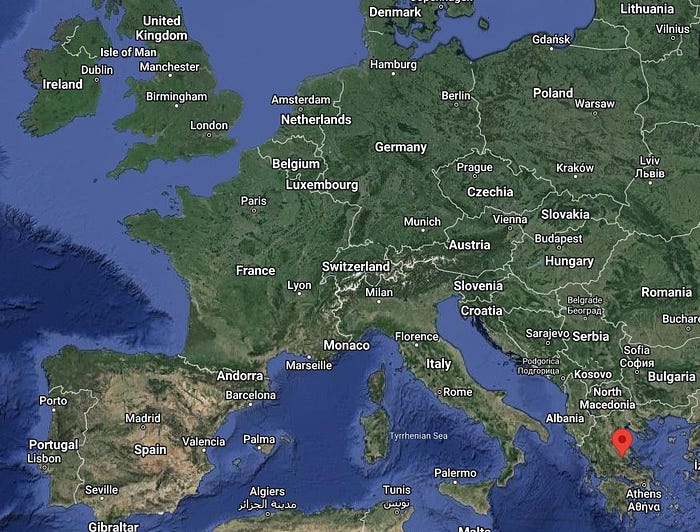
The municipality lies on the Piraeus-Platy Railway, a 457km/284mi double-tracked electrified main line originally opening in sections between 1883 and 1916 before a large refurbishment-project to overhaul, partially reroute and expand it to its current configuration ahead of the 2004 Olympics began in the late 1990s and finished in 2019. The line is a major rail corridor along Greece’s east coast and sees both passenger and freight services at speeds as high as 200kph/124mph.

The stretch of the rail line where the accident occurred had been constructed in 2003 as part of a modernization effort for the section between Larissa and Thessaloniki. Trains passed underneath the A1 motorway in two parallel tunnels (one for each track) alongside a third tunnel housing a small road, running at up to 160kph/99mph. The plans for the modernization included new signal box technology and ETCS (automatic train control), scheduled to be installed by 2016, but the systems were not in place by 2023. The trains and signal boxes were equipped with radio systems for communication, which were used to run the line via so called direct traffic control (DTC). DTC involves the dispatchers at different signal boxes working out what train is and should go where and individually giving permits to train drivers to proceed from one predetermined section of the line (“Block”) to the next either by turning signals green one by one or just giving verbal permission via the radio system so drivers knew they could disregard a red signal.
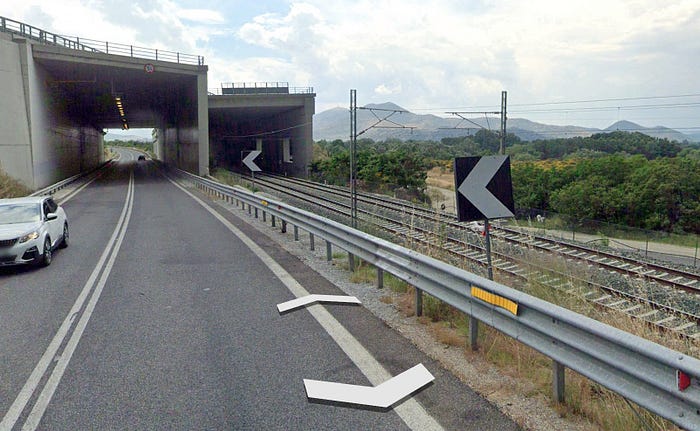
The Trains Involved
IC62 was an express passenger service from Athens to Thessaloniki, carrying 342 passengers and 10 crew members (four of which rode on the locomotive). The train, which was provided by Hellenic Train (a private rail service provider owned by the Italian national railway), consisted of five UIC Z1 passenger cars. The Z1 is a fairly modern four-axle Intercity car design by Siemens, introduced in 2008. The first car in the train was a restaurant car, followed by four standard passenger cars.
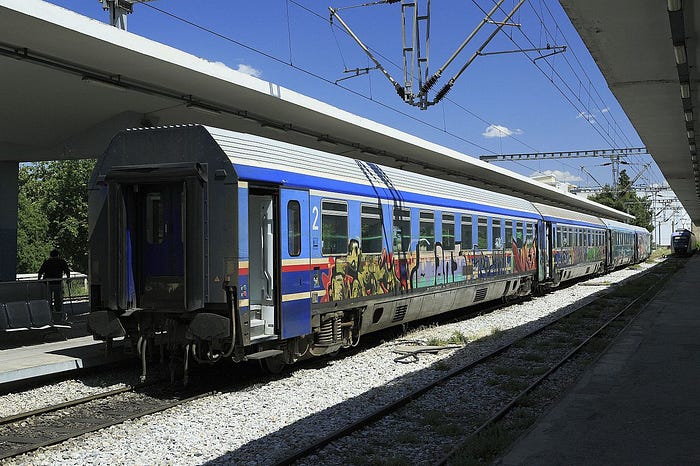
The train was pulled by OSE (Greek national railway) locomotive number 120–023. The Class 120 “Hellas Sprinter” is a four-axle multipurpose electric locomotive introduced in 1996, based off Siemens’ “EuroSprinter” locomotive family. Each Class 120 measures 19.58m/64ft in length at a weight of 80 metric tons and can reach 200kph/124mph thanks to a power output of 5000kW/6705hp.

Coming the other way was freight train 63503, a mixed freight service hauling shipping containers and sheet steel. It was hauled by a pair of OSE Class 120 locomotives (120–012 and -022) under the command of two drivers in the leading locomotive.
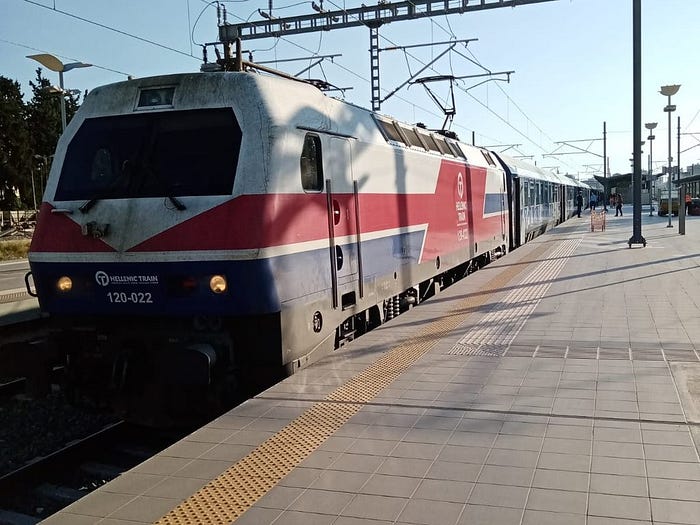
The Accident
IC62 from Athens to Thessaloniki was unusually busy on the 28th of February 2023, carrying a lot of students among its passengers who were returning to their universities after spending a long weekend celebrating Greek Orthodox Lent. An incident had occurred earlier in the day at Palaiofarsalos station south of Larissa when an overhead catenary snapped and fell on another intercity train, forcing it to stop and leading to various delays in the area. The delays also affected IC62, which only reached Larissa station just before 11pm, approximately 40 Minutes behind schedule.
The section of the line between Larissa and Neoi Poroi was, like the whole rail line, constructed in double-tracked configuration, but was only used as a single-track line at the time of the accident, running trains in both directions on the left hand (southbound) track. This had become necessary when a 2019 wildfire destroyed wiring and hardware for the remote operation of several sets of points, leaving the right hand track largely unusable. The signaling system wasn’t actually set up to allow trains in the wrong direction, so the exit-signal in front of IC62 was red and DTC-procedures were required to allow northbound trains to depart the station. IC62’s driver thus receives verbal permission from Mister Samaras, the dispatcher at the station, to disregard the signal and depart the station. The drivre obliges and departs the station northbound on the southbound track just after 11pm, heading for Neoi Poroi approximately 50km/31mi up the line. The locomotive crew likely doesn’t know that a freight train is heading southbound on the same track at the same time. Likewise, the freight train’s crew likely doesn’t know that anything is wrong as they rumble southbound through the Greek countryside in darkness at 80kph/50mph.
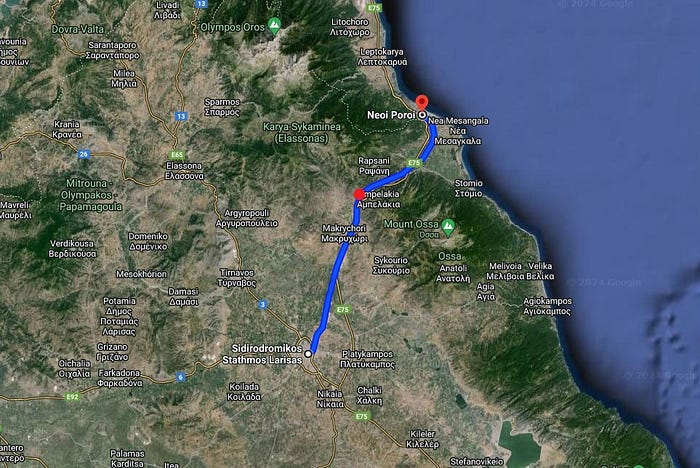
IC62 leaves the tunnel under the A1 Motorway at 11:21pm, travelling at 160kph/99mph. It’s likely right at that moment that the locomotive crew spots the headlights of the oncoming freight train in their path, but they don’t even have time to attempt an emergency stop before, moments later, the two trains slam into each other head-on at speed. The crash derails the first four cars of the Intercity and obliterates its locomotive while the freight train’s two locomotives are shoved into and onto the leading cars of their train. An explosion occurs right as the trains collide, starting a fire which ends up consuming the first two passenger cars and further damages other parts of the wreckage. 57 people, including both entire locomotive crews, die in the collision, while another 85 are injured, 25 of which severely.

Aftermath
A catastrophic event was declared within minutes of the accident, with 150 firefighters rushing to the scene to battle the fire while a further 40 ambulances and 30 police officers tried to rescue survivors and ensure nobody wandered off into the night in a shocked state. Experts would later estimate that temperatures in the burning passenger cars reached 1300°C/2370°F, making identification of some victims incredibly difficult. One of the victims was never recovered, being eventually declared dead without any remains ever identified. The Greek army was also called in to provide manpower for the recovery-effort once the blaze was extinguished. The accident is the deadliest in Greek rail history, claiming almost twice the lives of the prior holder of the tragic record.
The Greek government assembled for an emergency meeting after the accident and declared three days of national mourning, with flags flown at half-mast and celebratory events being cancelled. The EMAK (Greek special disaster management unit) was instructed to halt their recovery and cleanup-operation at the site until President Sakellaropoulou could visit the site, officially so she could “better understand the accident”. She was later photographed during that visit placing flowers inside and on burned and yet to be examined train cars, causing annoyance and confusion among investigators along with drawing public anger for prioritizing a “Photo session” over letting experts work on the wreckage.
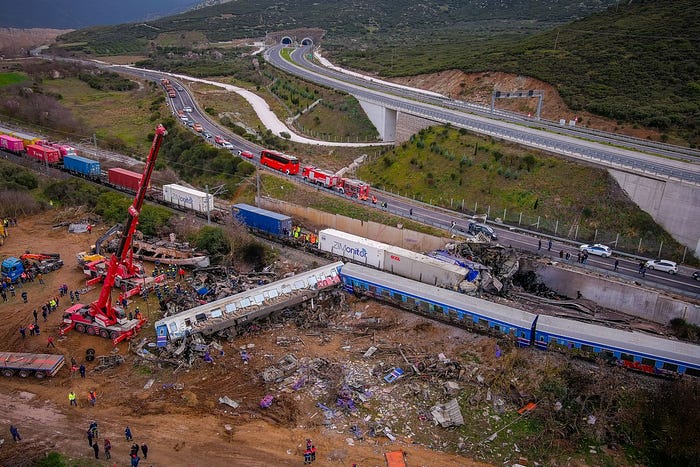
The police questioned Mister Samaras after the accident and quickly found out that he shouldn’t have been working the night of the accident. In fact, he shouldn’t have been working as a dispatcher at all. The accident happened on his 40th day on the job, with both his theoretical and practical training being yet to be completed. He was also 59 years old, despite the maximum age to become a dispatcher in Greece being 42 years. Worse yet, two more experienced dispatchers who were meant to oversee his work until their shift ends at 11pm left early, leaving him alone on the job by the time IC62 pulled into Larissa. The dispatcher at Neoi Poroi station also claimed to have tried contacting Mister Samaras to work out the operations between the two stations, without success.
Mister Varoufakis, the former Greek finance minister, blamed the accident on cost cutting as part of the “hideous railway privatization”, drawing comparisons to the Ladbroke Grove Train Collision in England in 1999 which had been largely blamed on a train protection system not being installed due to being deemed too expensive relative to its advantage.
The investigation presented a similar image, pointing out that modern signal boxes and ETCS-1 train control systems were meant to have been active for 7 years by the time of the accident. However, the installation of such systems was overseen not by the private rail service providers but by the government-owned OSE, which owned some rolling stock along with being responsible for the infrastructure. They, as it turned out, had first failed to issue permits to the contracted companies and then, once they finally got around to issuing permits, failed to ensure the contractors actually performed the work they were meant to perform in a timely fashion (or at all).
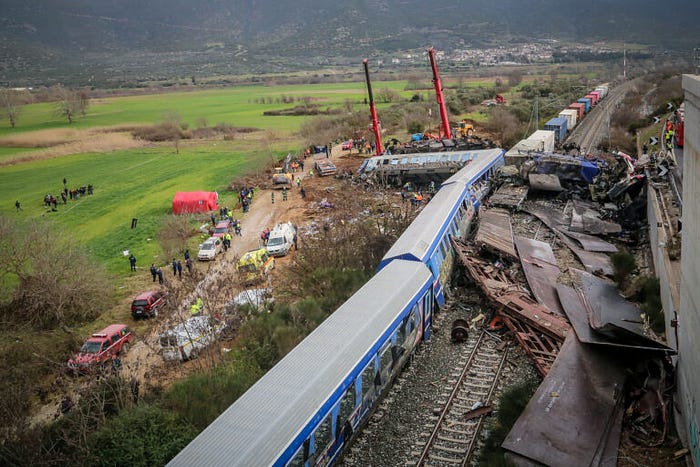
The train driver’s association piped up to point out they had been warning the public for a while that the government was working on legislation to make strikes over safety issues unlawful while the railway system in Greece was in a more than insufficient condition regarding safety-equipment and employee training. The accident also occurred two weeks after the EU had taken Greece to court for refusing the establishment of an independent rail accident investigation board, which was mandatory under EU law. The train driver’s association’s president also went public with a statement that vital safety systems and even basic instruments of operating a 21st century railway had been non-operational for years (if they were there at all), saying that “nothing works, everything is in manual mode”.
Mister Karamanlis, Greece’s traffic minister at the time, gave up his position on the first of March 2023, explaining that he felt it was his responsibility to take political responsibility but also emphasizing that the current government had been handed a rail system three years prior in a condition unfit for the 21st century. Vigils held for the victims turned into large-scale protests across Greece on the same day, reaching almost a million participants. Some of the protests turned into violent clashes with police that same night when protesters, angry over the lacking safety in Greek rail, reached Hellenic Train’s headquarters where police struggled to push them back, resorting to tear gas and physical violence.
This response only created further anger, accelerating the growth and spread of the protests. Videos from a protest in Athens on the fifth of March showed police officers ramming their motorbikes into crowds and using teargas on peacefully marching protesters, leading to solidarity protests in other European countries and yet larger protests across Greece, with the rail accident becoming a symbol of governmental failure and corruption. The protests were accompanied by a general strike in Greece’s entire rail system for over three weeks, wreaking havoc on logistics and the industry as the strike also led to issues at harbors and border crossings.
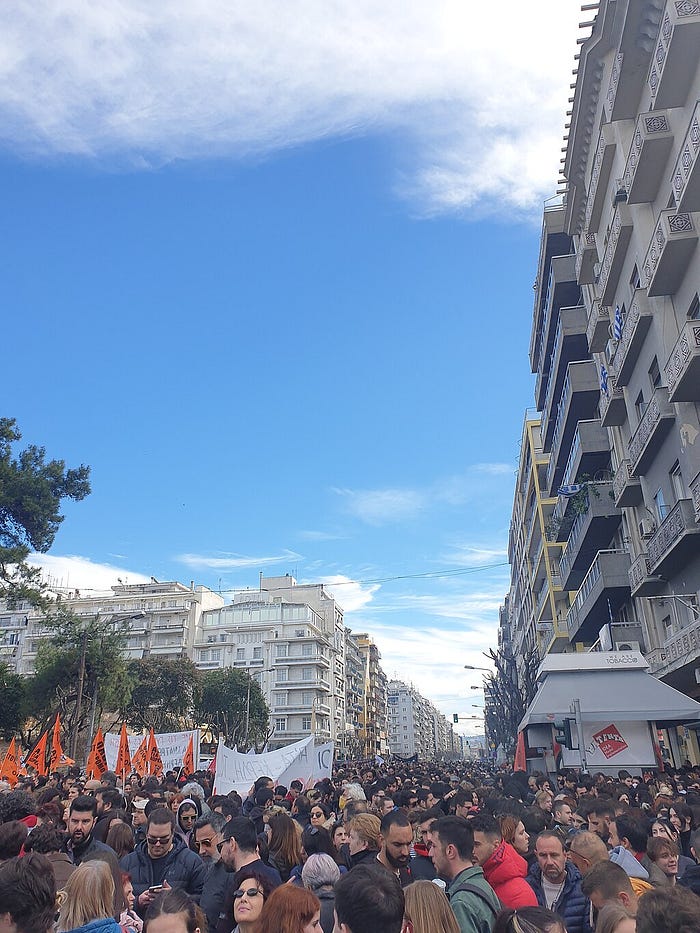
The European public prosecutor’s office (EPPO) decided to run an independent investigation as Greece lacked an independent investigative body, aiming to ensure a “backup” of sorts to compare with the official investigation’s results. A member of the EPPO’s team was quoted on their findings in January 2024, with a letter she wrote in June 2023 reading:
Suspicions have arisen regarding alleged criminal offences committed by former members of the Greek Government. These alleged criminal offences regard breach of duty committed by the former Minister [of Transport and Infrastructure] Christos Spirtzis and misappropriation committed by former [Prime] Minister Konstantinos A. Karamanlis [a cousin of the resigning traffic minister]. We ask for you to take your own actions.”
While EPPO had charged 23 suspects, including 18 public officials, for crimes linked to contracts on traffic control and signaling systems to be funded in part by EU money they couldn’t pursue misconduct investigations against former ministers, something only the Greek parliament could do under Greek law. And the parliament, unfortunately, buried the case by reaching a majority vote to not need an investigation.
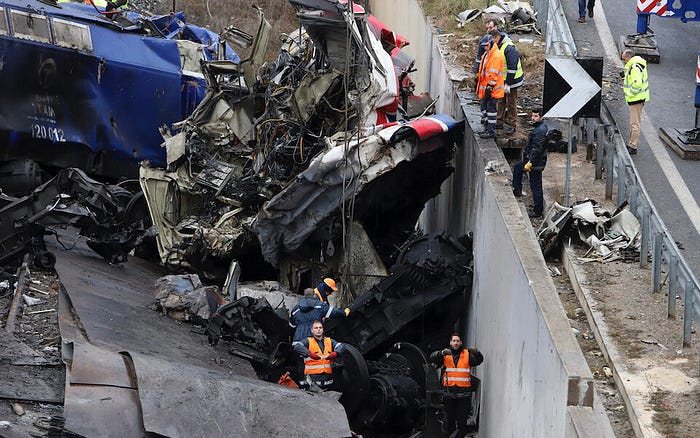
Relatives of the victims, dissatisfied with the lackluster investigation, contract independent experts to investigate the accident. The investigators only gained access to the site after the trains were removed and soil was replaced, but still stumbled over Xylol, a flammable solvent used mostly in the production of paint, in the ground. This, along with two other flammable chemicals found at the site by the independent investigators, indicated that the fire, which made the outcome of the accident significantly worse, may not have started when the kitchen of the restaurant car was destroyed (as the Greek government claimed) but was instead started by dangerous goods carried on the freight train’s forward cars (something the Greek government denied). Demands to see the freight documentation of the involved freight train were rejected, leaving the independent investigators unable to prove their theory. Mister Kokotsakis, head of the independent investigation, remarked that the aftermath of the tragedy was marked by “criminal negligence, purposeful omissions and actions meant to lead the official investigation to false results”. However, with the government refusing any sort of cooperation, there was little his investigation could do beyond pointing out discrepancies in and issues with the official investigation.
The Greek government managed to [excuse the unprofessional term] piss off the public once more on the 28th of February 2024, when victims’ parents wrote the names of the victims onto the sidewalk outside the Memorial for the unknown soldier in front of the parliament in Athens, only for the city government to have the names scrubbed off a few hours later.

The official investigation concluded that Mister Samaras (who appears to be still in custody as of February 2024, awaiting trial on charges of negligent manslaughter) was barely able to function as a dispatcher as long as he had the other dispatchers with him and operations went as planned, but began to lose track of the trains in his area once delays mixed up schedules. He had deemed the Intercity to be safe because the freight train wouldn’t need the track until after a regional train had followed the Intercity, forgetting that the regional train had been less affected by the delays and gone through ahead of the Intercity instead. This error led to him clearing the Intercity into the track occupied by the incoming freight train without ensuring that the track was actually clear. The locomotive crew of the Intercity reportedly did fail to inquire why they were directed into the oncoming track, which can be blamed on routine (they had been sent onto that track several times before since the other track hadn’t been operational for a while), but due to the crew perishing in the accident it will never be known for sure why they didn’t inquire. The inquiry, which is meant to be followed up by the dispatcher ensuring the track is clear especially under DTC procedures, may have avoided the accident as he would have found out about the freight train.
The whole situation that led to IC67 departing on the southbound track had only come about as the damage from the 2019 wildfire hadn’t been fixed in four years. The Intercity wouldn’t have had to depart on the oncoming track if all sets points had been operational, and even a few operational ones would have possibly allowed to move it out of the freight train’s path ahead of the accident. But as it were the train was meant to cover the whole section on the oncoming track without stopping, and the dispatcher cleared it for that.
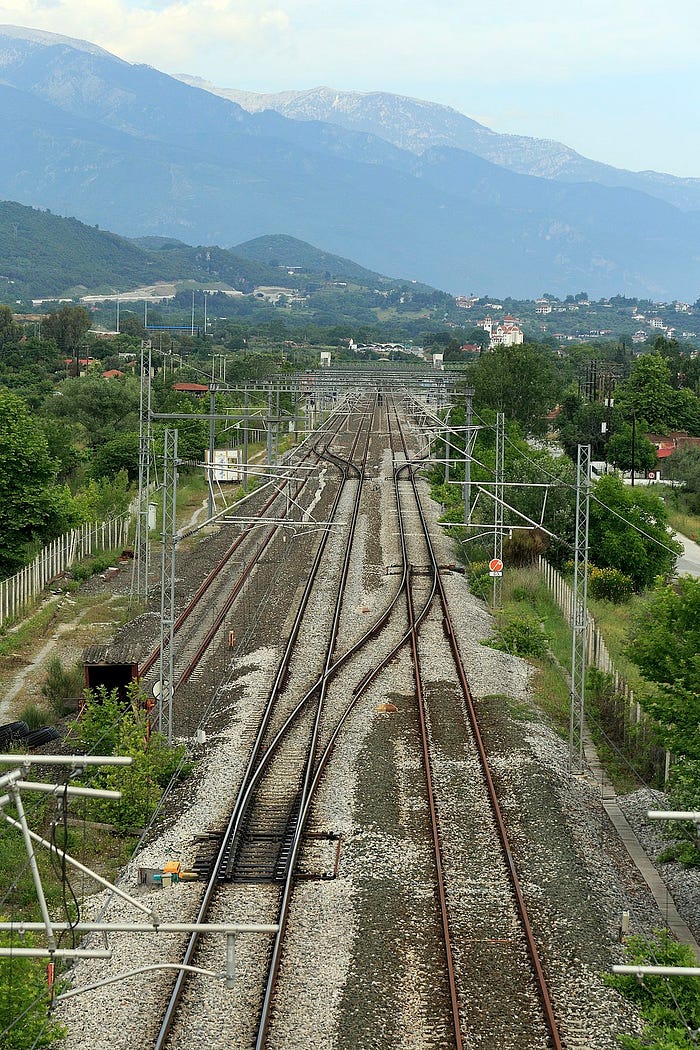
ETCS, a European train control system, can keep track of trains’ locations in the network and, since it could have tracked the freight train, would have brought the Intercity to a stop as it ran the red exit-signal (and entered an occupied track), but due to the governmental feet-dragging the system was only just being installed at the time of the accident. The exit-signal passed by IC67 had been red because it was on the southern track, which wasn’t meant to be used by northbound tracks. The capability of allowing trains in the opposite direction if required was part of the yet to be installed upgrades. Dispatchers were thus left to use DTC to override signals which were set to be permanently display red as their ability to change traffic direction was yet to be integrated, sending trains onto tracks they were supposed to be sure were clear. But without automatic train control there was nothing that kept trains from being sent on a collision course if the dispatchers messed up.
Railways are meant to operate on the principle that no single point of failure can cause a catastrophic event. One component in the system (in this case the dispatcher, precisely mainly Mister Samaras) failing to function as intended should be substituted by some other component to keep operations safe. That other component, in this case the ETCS system, was not operational at the time of the accident meaning the rail line was not operating on the basic principle of modern rail traffic.
It was never determined why the dispatcher at Neoi Poroi couldn’t reach Mister Samaras, the radio system was supposedly working as intended so the most likely explanation is that Samaras missed the radio call as he got overwhelmed with the traffic that had been mixed up by the delays.

Legal proceedings against Mister Samaras are ongoing as of February 2024, as are proceedings against three more individuals who were arrested and placed in investigative custody. They are Mister Samaras’ superior who put him on the shift as well as the two dispatchers who left their post before their shift ended, leaving Samaras alone. The three men face charges of interfering with traffic safety along with causing bodily injury in multiple cases. Some still claim that Samaras is a scapegoat of sorts, presented to be blamed to hide repeated and purposeful failures further up the hierarchy. It were his actions that led to accident in a direct sense, but there were obviously known issues that contributed in a significant way without which he wouldn’t even have been there at all. Furthermore, not only would operational ETCS have ensured that an erroneous dispatch of IC62 ends with a forced stop after just a few feet of track, it would have never even encountered a red signal as more timely repaired fire damage would have allowed it to use its own track.
OSE, Hellenic Train and rail worker unions had agreed in March 2023 that lower speed limits would be established on sections without automatic train control and all locomotives would at least be staffed with two drivers. The lower speed limits were marginal improvement of safety, while it’s unclear how double or even triple-staffing (Intercity trains) was meant to help when a four-man locomotive crew on IC62 hadn’t avoided the accident. Why exactly there were four times as many people in the cab of 120–023 as operation required remains outside public knowledge.
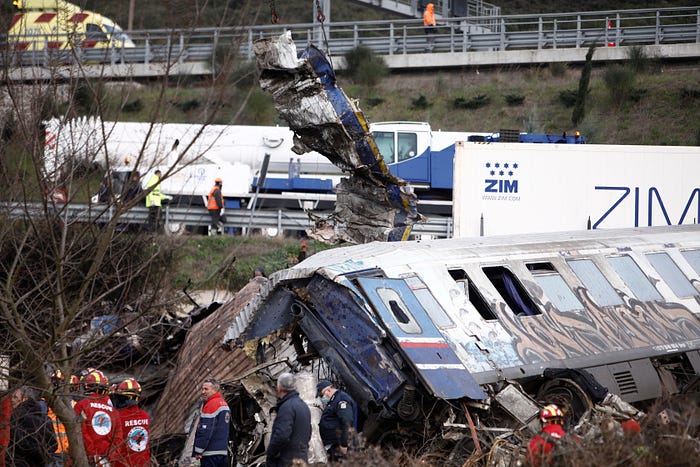
ETCS is now (March 2024) finally up and running on the line, making a repeat of the accident highly unlikely, but there is really no good reason why it wasn’t available to protect those aboard the freight train and IC62 a year ago.
Consequences in higher levels of the railway system and political apparatus have been just about nonexistent aside from a few resignations by CEOs and politicians, at least some of which soon continued their careers in other positions. This is largely credited to the Greek parliament’s decision not to pursue suspicions against its members provided by EPPO. Relatives of the victims started a petition, aiming to have political immunity reduced and change the Greek constitution so the parliament doesn’t hold the exclusive right to investigate itself. The petition holds 1.33 Million signatures as of early March 2024, with the next goal being 1.5 Million. Time will tell if actual change is coming.

_______________________________________________________________
I have chosen to stay off Medium’s monetization offers to keep these stories as accessible as possible, but you can support me with a small tip via “Buy me a coffee” if you feel like it.
_______________________________________________________________
A kind reader is posting the installments on reddit for me, I cannot interact with you there but I will read the feedback and corrections. You can find the post right here.
